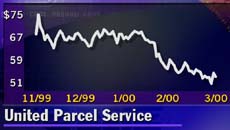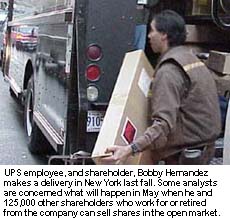|
Stock blues for Big Brown
|
 |
March 10, 2000: 2:34 p.m. ET
UPS stock down steadily since IPO, as investors see it as more 'old economy'
By Staff Writer Chris Isidore
|
NEW YORK (CNNfn) - When United Parcel Service had its record initial public offering in November, some fans described the company's stock as an instant blue chip. Since then it's become clear that's not necessarily a good thing.
The Atlanta parcel delivery company went public Nov. 10 with investors excited about it as a profitable, large cap Internet play, due to its leading position delivering consumers' online purchases.
Even with a $50 IPO price that was almost twice the value of shares the day before, the stock opened up 30 percent on the first trade at 65. It closed the day at 67-1/4.
Two days later it hit an intra-day high of 76-15/16, or about 38 times earnings for the year.
Its stock hasn't been the same since.
 The world's largest transportation company hasn't really done anything wrong since then. It slightly exceeded earnings expectations in the fourth quarter, apparently grabbing some market share for the profitable express business away from FedEx Corp. (FDX: Research, Estimates) and other air express companies. The world's largest transportation company hasn't really done anything wrong since then. It slightly exceeded earnings expectations in the fourth quarter, apparently grabbing some market share for the profitable express business away from FedEx Corp. (FDX: Research, Estimates) and other air express companies.
It eschewed the fuel surcharge option of many transportation companies, saying fuel accounts for less than 2 percent of revenue and that it is well hedged with long-term fuel contracts.
Before the IPO UPS' shares were held by 126,000 UPS employees and retirees, along with various trusts of the founders' decedents. Those shareholders, who between them still own the 90 percent of the company, like UPS' prospects so much that a company tender offer for their shares at above-market prices went undersubscribed last week. Only 68 percent of potential shares cashed in at $60 a share.
Company now tarred with 'old economy' stigma
However, on Tuesday UPS (UPS: Research, Estimates) stock hit an intra-day low of 49, the first time it has dropped below the IPO price, before it rebounded slightly. It was trading up 1/4 at 53-1/4 Friday afternoon.
Of course Tuesday's low came on the day of the nearly 375-point plunge for the Dow Jones industrial average, when many "old economy" stocks were hurt by an earnings from Procter & Gamble Co.
But that is part of the problem. Analysts say many investors' view of the stock has changed from being a popular Internet play to a more traditional industrial giant, just at the time that such stocks have fallen out of favor with investors. So it is less attractive even if the fundamentals haven't changed.
"I think people still think of UPS as a strong and good company, but I think people are more rational now," said Doug Rockel, analyst with ING Barings. "They came in with fine earnings, but it wasn't the Internet play that people thought. The realization that traffic was up 5 percent, and that is equal to GDP growth, not two, three or 20 times GDP growth. The stock at that time had a premium valuation. Some of that premium has evaporated."
Strong earnings bring stock sell-off
There was no clearer sign of the change in thinking about the stock than on Jan. 31, when the company reported record fourth-quarter profit of $661 million, or 56 cents a share. That was 37 percent ahead of the year-ago number and 1 cent a share better than consensus forecasts.
But the stock fell 4-15/16, or 8 percent, that day. It rebounded slightly the next day but hasn't reached that price since.
"I think the hate to say it was a rude awaking with the fourth-quarter report, but there a sort of the recognition that old economy or new economy, this is a company tied to the economy," said Schlesinger. "Here or there you can find flaws, but it's a pretty strong company. However, if the economy slows down, it slows down for them too."
Company officials wouldn't comment on the stock's performance directly, but said they were not overly concerned with the slide in price since the IPO.
"We're a key enabler of e-commerce. But we've never suggested to anyone that you should look at UPS the way you would a dot.com start-up," said Norman Black, spokesman for the company. "We are a 92-year old, the largest in the world in its business. On a percentage basis, if you're looking for quarter-to-quarter triple-digit jumps in volume, you're not going to see it."
Black pointed out that because of the structure of IPO, 99 percent of the voting rights are still held by employees, retirees and decedents of the company, and that there is no great pressure on management due to the price of stock.
"Were people disappointed to see the reaction that day? We certainly were," he said. "We were incredibly pleased with our '99 performance, and it was disappointing the market didn't recognize what an industry leading performance it was. But inside this company, nothing has changed."
Analysts still not bullish on stock
Rockel and many transportation analysts have been neutral on the stock since they started coverage shortly after the IPO, due to inflated pricing. Even with the lower prices, many analysts say it is still not the bargain compared with other successful transportation companies.
"I have a target price for UPS at 60," said Paul Schlesinger, analyst with Donaldson, Lufkin & Jenrette Securities. "But sad to say, most transportation stocks are so far below what I think are fair target price, that it doesn't stand out as a bargain."
Other analysts say that as concerns about fuel abate, the price of UPS stock should start to regain its early luster.
"We've never seen a beast like UPS," said Ed Wolfe, analyst with Bear Stearns "It's best in class, six times bigger than its next largest competitor. They set pricing. They have best returns in the integrated (freight transportation) sector."
Some analysts express concern over large sales of the stock on or soon after May 8, when the shareholders of the formerly privately held shares will be able to sell up to one-third of their shares on the open market. That equals 305 million shares, almost triple the number of shares offered in the IPO.
But a mass sell-off seems unlikely, since only 68 percent of the shares eligible for the company's tender offer of $60 a share were sold back to the company, despite a market price as low as 52-1/2 during the period.
 "The tender offer tells me a lot of ups employees are incredibly loyal, that they believe in the company long-term," said Rockel. "But I think there could be some selling of shares and until that overhang is taken up through higher demand, it will put pressure on the stock." "The tender offer tells me a lot of ups employees are incredibly loyal, that they believe in the company long-term," said Rockel. "But I think there could be some selling of shares and until that overhang is taken up through higher demand, it will put pressure on the stock."
Wolfe thinks the record of the tender offer proves relatively few shares will come onto the market in May. Even the most optimistic employee could have sold his UPS shares at 60 and bought more at the lower price, although with purchase prices for many shares in the teens, they would have been hit with a capital gains penalty. But it was the company's culture, not tax law, that stopped many from selling, Wolfe said.
"I can tell you, my assistant's husband is a Teamsters at UPS, and I asked her if they were going to sell shares," he said. "She said, 'No that's for the kids.' That's just the way most of those employees are.
"There will be relatively few shares sold," predicted Wolfe. "And UPS still has $1 billion left over from the IPO to repurchase shares on the open market to support the price if need be."
Black confirmed the company is looking at that option, but has made no decision on repurchases at this time. 
-- Click here to send email to Chris Isidore
|
|
|
|
|
|
UPS
|
Note: Pages will open in a new browser window
External sites are not endorsed by CNNmoney
|
|
|
|
 |

|

